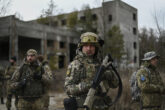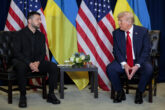July 22, 2014
Putin’s South American Trip Hides Russia’s Strategic Weaknesses
Although Russian President Vladimir Putin’s visit to South America earlier this month was overshadowed by events in Ukraine and the Middle East, it did garner considerable attention in the South American and Russian media. Even in Washington, commentators saw Putin as seeking to circumvent the Western opposition to his policies in Ukraine as well as retaliate for U.S. involvement in Moscow’s neighboring states with a tit-for-tat display of influence in Washington’s strategic backyard.
Putin began his visit in Cuba on July 11, where he finalized plans to eliminate 90 percent of Cuba’s Cold War-era debt to Russia—more than $30 billion out of $35 billion—and convert the remainder to a special joint development fund to support new Russian-Cuban projects. After a brief stop in Nicaragua, he then traveled to Argentina, where he oversaw a nuclear energy cooperation agreement and other deals. In Brazil, his last stop, he watched the World Cup soccer final, signed new economic measures and attended the sixth annual BRICS summit—later joined by other South American leaders—before flying home on July 16.
But a false report that Russia planned to restore its electronics listening post at Lourdes in Cuba, like earlier U.S. fears that Russia planned to build permanent military bases in the Western Hemisphere, reflects unrealistic expectations of Moscow’s capabilities and willingness to confront Washington in a region of peripheral concern to most Russian policymakers. Putin has since indicated that Russia has no plans to relaunch Lourdes as a signals intelligence center, while the government has clarified that the Russian navy only wants access to temporary support centers and not permanent bases in the hemisphere.
More from CNAS
-
Transatlantic Security / Middle East Security
The Russia-Iran Partnership: A Geopolitical Balancing ActIt has been almost a year since Russia and Iran signed their comprehensive strategic partnership. That deal established a 20-year partnership between the two countries coverin...
By Andrea Kendall-Taylor & Jim Townsend
-
Defense / Transatlantic Security
Ukraine’s Catch-22 MomentThis article was originally published in the Financial Times. In Joseph Heller’s wartime classic, Catch-22, the protagonist Yossarian seeks out the US army surgeon Doc Daneeka...
By Franz-Stefan Gady
-
Transatlantic Security / Middle East Security / Energy, Economics & Security
Sanctions Aren’t Enough to Shut Down the Moscow-Tehran Black Market for WarThe geographic scope and extent of Iranian-Russian cooperation highlights the failure of traditional sanctions to prevent Moscow and Tehran from seeking key components like ch...
By Delaney Soliday
-
What’s Driving President Trump’s New Confidence in Ukraine’s War Effort
President Trump dramatically declared on social media that he now believes that Ukraine can reclaim all its land from Russia, which he described as a paper tiger. From the Ova...
By Richard Fontaine




